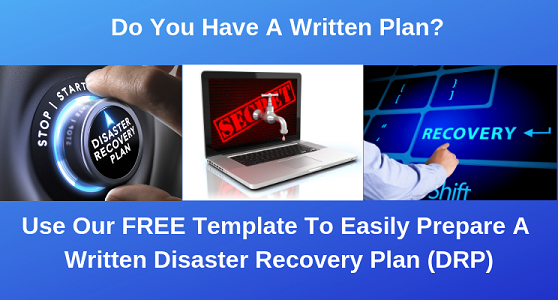Are You Under-prepared for disaster?
Top executives of all organizations are tasked with making sure their companies can continue operating no matter what happens. Today, there are so many threats that can derail a business: Malware, Ransomware, Cyber-attacks, Hurricanes, floods, fires, etc.
The simple truth: it is not a matter of if but when your company will experience a disaster.
Yet despite the recent emphasis on security in the news, statistics show that 30% of businesses do not even have a written Disaster Recovery Plan (DRP).
This short article will show you what you need to get a basic DRP in place plus we’ll show you a shortcut to getting a plan much quicker. Here’s what you need to consider:
Create a Threat Matrix
List all of the types of threats that can happen taking your geography into consideration. Really think this through and list all that you and your team can think of.
Once done, rate each threat using a High, Medium, Low score then reference the procedure and processes your company has so to deal with these situations. If you don’t have procedures in place covering the threats you’ve identified, then they will need to be created as well.
Identify Critical Processes
All companies have critical processes and systems that they need to continue doing business.
List the process (i.e. payroll, accounts receivable, etc.), the manager and employees involved, backup personnel, physical and system requirements, software and records needed and alternate work location.
This information will serve you well and also identify the critical IT systems that must be recovered first after a disaster.
Have A Communication Plan
When disaster strikes, everyone should know how to communicate with management and staff via alternate means. If you have a large number of employees and departments, then managers should be responsible for notifying their staff and keeping them updated.
Additionally, only certain executives should be designated as the only ones to speak on the company’s behalf to the press and to post to the internet and social media.
Other Areas To Include In Your Written Disaster Plan
- The designated person(s) who can officially declare an emergency
- How to handle the evacuation of facilities
- The location of backup facilities
- Emergency vendor contact information
- Employee contact information
- Vendor list
- Client contact information
- Insurance, Financial, Legal contacts
- Licenses and permits
- IT Disaster Recovery Systems
- Hardware & software inventory
A Shortcut (As Promised)
We created a Disaster Recovery Template that you can use immediately to get started. It is in Microsoft Excel and contains a tab for each area that we’ve mentioned above. The template is absolutely free with no registration requirement. Just download it and use it.
To get your FREE Disaster Recovery Template:
- Go to https://xsolutions.com/resources/
- Click Downloads
- Find the template called, “Disaster Recovery Plan”; it’s the very first one.
- Click the Download button
Conclusion
Now that you have your free Disaster Recovery template, there is no reason for any delay. Complete each tab and in the end your company will have an actionable, written Disaster Recovery Plan.
After your DRP is completed, don’t forget to test your plan periodically, make needed changes and expand upon it as your situation evolves. A DRP is a “living document” and should change as your organization changes. Start now.
XSolutions is an Elite Partner of Datto, the world leader in Hybrid-Cloud Business Continuity solutions whose systems protect 460+ Petabytes of data with over 1400+ employees and 9 offices around the globe. Call (845) 362-9675 and let us introduce you to the ultimate defense against data loss—whatever the cause. Backup & Disaster Recovery | Business Continuity | Data Risk Assessment










